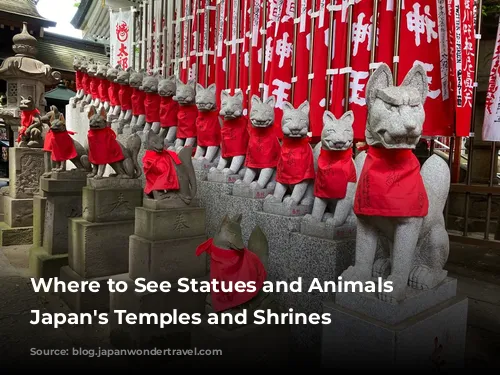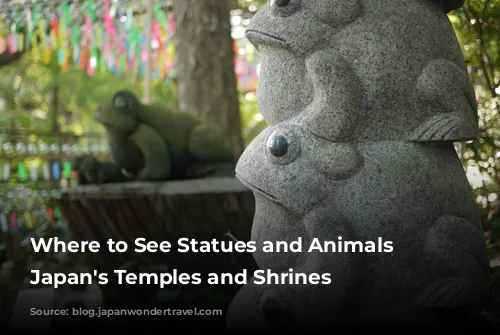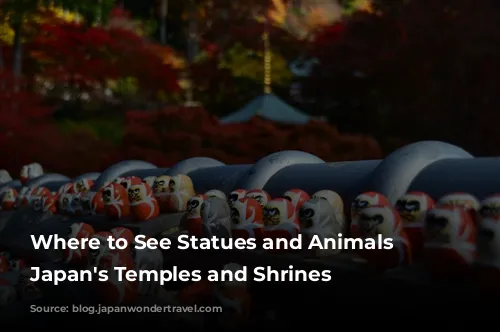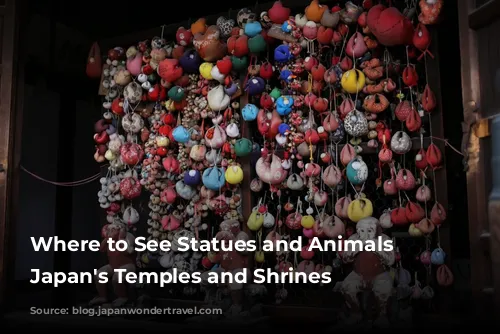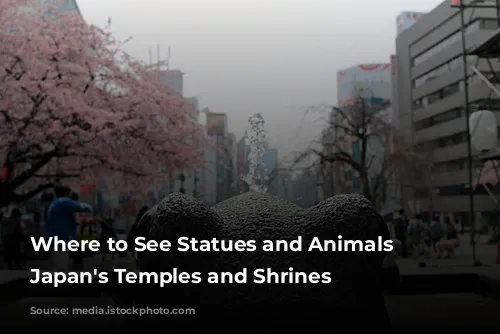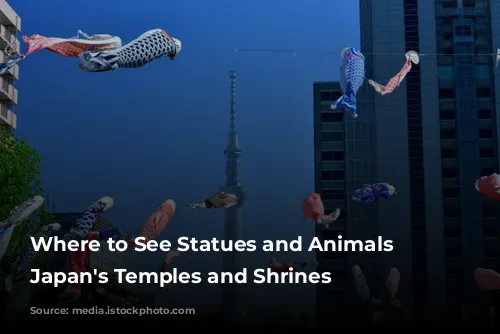Welcome, fellow travelers, to a journey through Japan’s enchanting world of temples and shrines! While these spiritual sanctuaries offer serenity and beauty, there’s something even more intriguing: the presence of animals, both real and symbolic. From lucky cats to guardian foxes, these creatures hold deep significance within Japanese folklore and traditions. Get ready to discover some of the most remarkable animal-themed temples and shrines across the country!
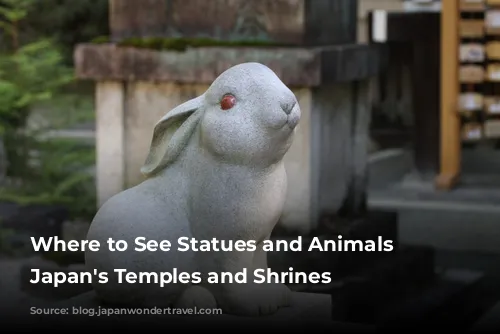
The Temple of Lucky Cats: Gotokuji
Nestled in Tokyo’s serene Setagaya district lies Gotokuji Temple, a Buddhist sanctuary renowned as the birthplace of the beloved maneki-neko, or lucky cats. The temple grounds are a veritable wonderland of these charming figurines, their numbers ever-growing as visitors leave their own maneki-neko as offerings.
Legend has it that in the early 17th century, a feudal lord named Ii Naotaka sought shelter from a fierce thunderstorm. A cat, extending its paw in invitation, led him to the temple, saving his life. In gratitude, Ii Naotaka dedicated the temple to his clan, and the maneki-neko became a cherished symbol of good fortune.
Each maneki-neko holds a unique charm: those raising their right paw beckon wealth, while those raising their left welcome people. Gotokuji specializes in the right-pawed variety, making it a popular destination for those seeking prosperity.
How to get to Gotokuji Temple:
Toyokawa Inari Tokyo Betsuin Temple: A Sanctuary of Foxes
In the heart of Tokyo, you’ll find Toyokawa Inari Tokyo Betsuin Temple, a branch temple of the main Toyokawa Inari Temple in Aichi Prefecture. This temple welcomes visitors with an abundance of fox statues, crafted from stone in various shapes, sizes, and expressions.
Foxes are considered sacred messengers and servants of Inari, the deity of rice and agriculture. At all Inari shrines and temples across Japan, you’ll encounter these creatures. Today, Toyokawa Inari Tokyo Betsuin holds special significance for those seeking success in the entertainment industry.
The temple itself is a fascinating blend of Buddhist and Shinto traditions. The main building features a Buddhist atmosphere and decor while venerating the Shinto deity Inari. Benzaiten, the god of art and entertainment and one of the Seven Lucky Gods, resides in a building adjacent to the main structure. The other Seven Lucky Gods can be found behind the numerous red flags adorning the temple grounds.
How to get to Toyokawa Inari Tokyo Betsuin:
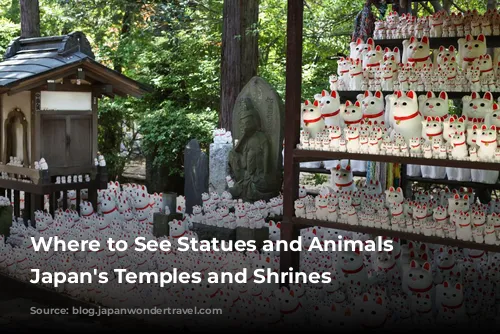
Okazaki Shrine: A Sanctuary for Rabbits
Just a short distance east of Kyoto’s Heian Shrine lies Okazaki Shrine, a small but significant sanctuary where rabbit statues abound. Founded over 1,200 years ago, Okazaki Shrine played a vital role in protecting the city from evil.
Rabbits are seen as servants and messengers of the enshrined deity, and their association with fertility makes Okazaki Shrine a popular destination for couples hoping for children and expectant mothers. A large black rabbit named Kasuzuke Usagi, meaning “fertility bunny,” is a particularly significant figure. Pouring water over its head and rubbing its belly is believed to ensure a smooth childbirth.
How to get to Okazaki Shrine:
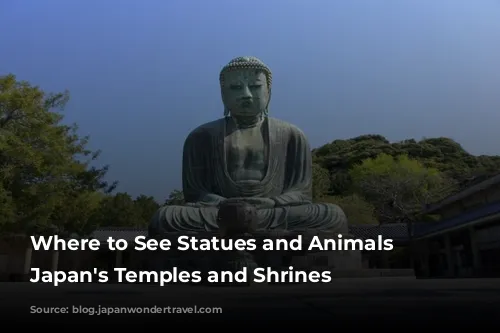
Nyoirinji Temple: The Temple of Frogs
Nestled in a tranquil countryside town in Fukuoka Prefecture, Nyoirinji Temple is renowned for its over 5,000 frog statues, earning it the nickname “Kaeru-dera,” meaning “frog temple.”
The temple, founded in 729, houses a standing Nyoirin Kannon statue, designated as an important cultural property. The collection of frog figures began just 25 years ago when a chief priest returned from China with a small jade frog figurine. The word “kaeru” has two meanings in Japanese: “frog” and “return.” The priest began collecting frog statues, transforming Nyoirinji into a fun and welcoming place for visitors.
Nyoirinji is also a delight for nature lovers, offering breathtaking views of blooming azaleas and cherry blossoms in spring, vibrant hydrangeas and wind chimes in summer, and autumn’s fiery foliage.
How to get to Nyoirinji Temple:
Yasaka Koshindo: A Colorful Sanctuary of Monkeys
In Kyoto’s bustling Higashiyama area, you’ll find Yasaka Koshindo, a small temple overflowing with color. Dedicated to Shomen Kongo, a guardian warrior who rewards good deeds and punishes evil, Yasaka Koshindo is a place of hope and justice.
Visitors write their wishes on colorful fabric balls called “kukurizaru” and hang them at the temple. Kukurizaru symbolizes the good faith monkey with bound feet and hands. The temple also houses wooden carvings of the “hear no evil, see no evil, speak no evil” monkeys. In Japanese folklore, monkeys are seen as benevolent spirits that protect people and their homes from evil forces.
How to get to Yasaka Koshindo:
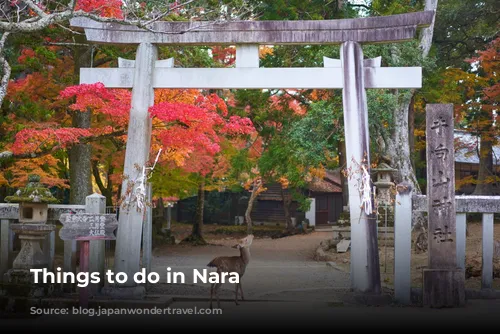
Katsuoji Temple: The Temple of Winning Daruma Dolls
Located in Mino city, Osaka Prefecture, Katsuoji Temple is home to a vast collection of daruma dolls, earning it the titles “Winning Daruma Doll Temple” and “Victory Temple.”
The daruma, representing the founder of Zen Buddhism, symbolizes perseverance and the pursuit of goals. The daruma at Katsuoji are known as “kachi daruma” (winning daruma).
When purchased, the daruma’s eyes are white. Write down your goal on the bottom of the doll and paint in its right eye. Display the daruma prominently for inspiration, and once your goal is achieved, paint in the left eye and return the doll to the temple.
Katsuoji attracts those seeking success in school, exams, love, sports, and more.
How to get to Katsuoji Temple:
Nara Park: Where Deer Roam Free
While not a temple or shrine per se, Nara, known for its historical temples and the Great Buddha, is a must-visit destination because of its free-roaming deer. Nara Park, established in 1880, is home to over 1,200 deer, considered sacred and designated as a natural treasure.
Feeding the deer is a unique and unforgettable experience. Purchase special crackers (Shika-senbei) sold throughout the park. The deer, accustomed to human presence, may even bow to you if you bow first. However, they can be mischievous and sometimes even aggressive, so be cautious with your food.
How to get to Nara Park:
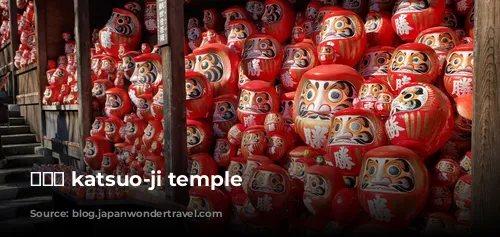
Animals at Shrines and Temples: More Than Just Decorations
Throughout Japan, animal statues and living creatures are common sights at shrines and temples. These creatures hold special meanings, often rooted in local legends or reflecting their role in Japanese folklore.
- Foxes are messengers of the Inari deities.
- Lion and dragon-like statues called komainu guard temple entrances, warding off evil spirits.
- Cow statues are believed to heal injuries or grant wisdom when rubbed.
- Mice symbolize health, long life, happiness, and matchmaking.
- Doves serve as messengers of Hachiman, the god of war and protector of Japan.
These captivating animals enrich the spiritual experience of visiting Japan’s shrines and temples. Each encounter with these creatures adds another layer of meaning to the journey.
So, on your next adventure through Japan, be sure to keep an eye out for these incredible animals, both living and in statue form. Their presence adds a touch of magic and wonder to the journey.
